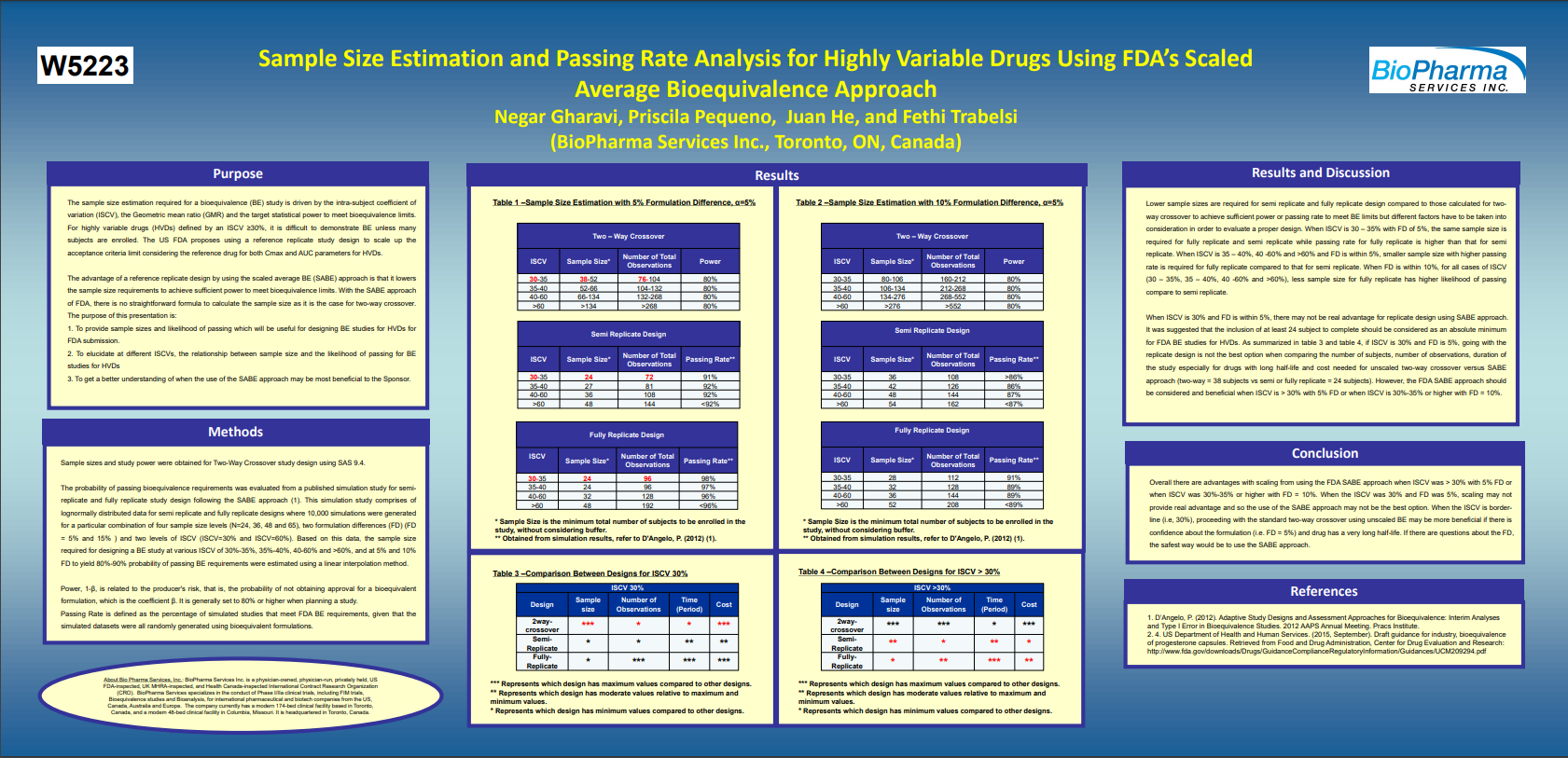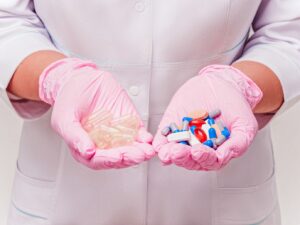Sample Size Estimation and Passing Rate Analysis for Highly Variable Drugs Using FDA’s Scaled Average Bioequivalence Approach
PRESENTED TO: BioPharma Services Inc.
PRESENTED BY: Negar Gharavi, Priscila Pequeno, Juan He, and Fethi Trabelsi
PURPOSE
The sample size estimation required for a bioequivalence (BE) study is driven by the intra-subject coefficient of variation (ISCV), the Geometric mean ratio (GMR) and the target statistical power to meet bioequivalence limits. For highly variable drugs (HVDs) defined by an ISCV ≥30%, it is difficult to demonstrate BE unless many subjects are enrolled. The US FDA proposes using a reference replicate study design to scale up the acceptance criteria limit considering the reference drug for both Cmax and AUC parameters for HVDs.
The advantage of a reference replicate design by using the scaled average BE (SABE) approach is that it lowers the sample size requirements to achieve sufficient power to meet bioequivalence limits. With the SABE approach of FDA, there is no straightforward formula to calculate the sample size as it is the case for two-way crossover. The purpose of this presentation is:
1. To provide sample sizes and likelihood of passing which will be useful for designing BE studies for HVDs for FDA submission.
2. To elucidate at different ISCVs, the relationship between sample size and the likelihood of passing for BE studies for HVDs
3. To get a better understanding of when the use of the SABE approach may be most beneficial to the Sponsor.
RESULTS
Table 1 –Sample Size Estimation with 5% Formulation Difference, α=5%
Table 1 –Sample Size Estimation with 5% Formulation Difference, α=5%
Two – Way Crossover
| ISCV | Sample Size* | Number of Total Observations | Power |
| 30-35 | 38-52 | 76-104 | 80% |
| 35-40 | 52-66 | 104-132 | 80% |
| 40-60 | 66-134 | 132-268 | 80% |
| >60 | >134 | >268 | 80% |
Semi Replicate Design
| ISCV | Sample Size | Number of Total Observations | Passing Rate** |
| 30-35 | 24 | 72 | 91% |
| 35-40 | 27 | 81 | 92% |
| 40-60 | 36 | 108 | 92% |
| >60 | 48 | 144 | <92% |
Fully Replicate Design
| ISCV | Sample Size | Number of Total Observations | Passing Rate** |
| 30-35 | 24 | 96 | 98% |
| 35-40 | 24 | 96 | 97% |
| 40-60 | 32 | 128 | 96% |
| >60 | 48 | 192 | <96% |
* Sample Size is the minimum total number of subjects to be enrolled in the study, without considering buffer.
** Obtained from simulation results, refer to D’Angelo, P. (2012) (1).
Table 3 – Comparison Between Designs for ISCV 30%
| Design | Sample size | Number of Observations | Time | Cost |
| 2way-crossover | *** | * | * | *** |
| Semi-Replicate | * | * | ** | ** |
| Fully-Replicate | * | *** | *** | *** |
*** Represents which design has maximum values compared to other designs.
** Represents which design has moderate values relative to maximum and minimum values.
* Represents which design has minimum values compared to other designs
RESULTS AND DISCUSSION
Lower sample sizes are required for semi replicate and fully replicate design compared to those calculated for twoway crossover to achieve sufficient power or passing rate to meet BE limits but different factors have to be taken into consideration in order to evaluate a proper design. When ISCV is 30 – 35% with FD of 5%, the same sample size is required for fully replicate and semi replicate while passing rate for fully replicate is higher than that for semi replicate. When ISCV is 35 – 40%, 40 -60% and >60% and FD is within 5%, smaller sample size with higher passing rate is required for fully replicate compared to that for semi replicate. When FD is within 10%, for all cases of ISCV (30 – 35%, 35 – 40%, 40 -60% and >60%), less sample size for fully replicate has higher likelihood of passing compare to semi replicate.
When ISCV is 30% and FD is within 5%, there may not be real advantage for replicate design using SABE approach. It was suggested that the inclusion of at least 24 subject to complete should be considered as an absolute minimum for FDA BE studies for HVDs. As summarized in table 3 and table 4, if ISCV is 30% and FD is 5%, going with the replicate design is not the best option when comparing the number of subjects, number of observations, duration of the study especially for drugs with long half-life and cost needed for unscaled two-way crossover versus SABE approach (two-way = 38 subjects vs semi or fully replicate = 24 subjects). However, the FDA SABE approach should be considered and beneficial when ISCV is > 30% with 5% FD or when ISCV is 30%-35% or higher with FD = 10%.

METHOD(S)
Sample sizes and study power were obtained for Two-Way Crossover study design using SAS 9.4.
The probability of passing bioequivalence requirements was evaluated from a published simulation study for semireplicate and fully replicate study design following the SABE approach (1). This simulation study comprises of lognormally distributed data for semi replicate and fully replicate designs where 10,000 simulations were generated for a particular combination of four sample size levels (N=24, 36, 48 and 65), two formulation differences (FD) (FD= 5% and 15% ) and two levels of ISCV (ISCV=30% and ISCV=60%). Based on this data, the sample size required for designing a BE study at various ISCV of 30%-35%, 35%-40%, 40-60% and >60%, and at 5% and 10% FD to yield 80%-90% probability of passing BE requirements were estimated using a linear interpolation method.
Power, 1-β, is related to the producer’s risk, that is, the probability of not obtaining approval for a bioequivalent formulation, which is the coefficient β. It is generally set to 80% or higher when planning a study. Passing Rate is defined as the percentage of simulated studies that meet FDA BE requirements, given that the simulated datasets were all randomly generated using bioequivalent formulations
Table 2 –Sample Size Estimation with 10% Formulation Difference, α=5%
Two – Way Crossover
| ISCV | Sample Size* | Number of Total Observations | Power |
| 30-35 | 80-106 | 160-212 | 80% |
| 35-40 | 106-134 | 212-268 | 80% |
| 40-60 | 134-276 | 268-552 | 80% |
| >60 | >276 | >552 | 80% |
Semi Replicate Design
| ISCV | Sample Size | Number of Total Observations | Passing Rate** |
| 30-35 | 32 | 108 | >86% |
| 35-40 | 42 | 126 | 86% |
| 40-60 | 48 | 144 | 87% |
| >60 | 54 | 162 | <87% |
Fully Replicate Design
| ISCV | Sample Size | Number of Total Observations | Passing Rate** |
| 30-35 | 28 | 112 | 91% |
| 35-40 | 32 | 128 | 89% |
| 40-60 | 36 | 144 | 89% |
| >60 | 52 | 208 | <89% |
* Sample Size is the minimum total number of subjects to be enrolled in the study, without considering buffer.
** Obtained from simulation results, refer to D’Angelo, P. (2012) (1).
Table 4 –Comparison Between Designs for ISCV > 30%
| Design | Sample size | Number of Observations | Time | Cost |
| 2way-crossover | *** | *** | * | *** |
| Semi-Replicate | ** | * | ** | ** |
| Fully-Replicate | * | ** | *** | ** |
*** Represents which design has maximum values compared to other designs.
** Represents which design has moderate values relative to maximum and minimum values.
* Represents which design has minimum values compared to other designs
CONCLUSION
Overall there are advantages with scaling from using the FDA SABE approach when ISCV was > 30% with 5% FD or when ISCV was 30%-35% or higher with FD = 10%. When the ISCV was 30% and FD was 5%, scaling may not provide real advantage and so the use of the SABE approach may not be the best option. When the ISCV is borderline (i.e, 30%), proceeding with the standard two-way crossover using unscaled BE may be more beneficial if there is confidence about the formulation (i.e. FD = 5%) and drug has a very long half-life. If there are questions about the FD, the safest way would be to use the SABE approach.
REFERENCES
1. D’Angelo, P. (2012). Adaptive Study Designs and Assessment Approaches for Bioequivalence: Interim Analyses and Type I Error in Bioequivalence Studies. 2012 AAPS Annual Meeting. Pracs Institute.
2. 4. US Department of Health and Human Services. (2015, September). Draft guidance for industry, bioequivalence of progesterone capsules. Retrieved from Food and Drug Administration, Center for Drug Evaluation and Research: http://www.fda.gov/downloads/Drugs/GuidanceComplianceRegulatoryInformation/Guidances/UCM209294.pdf
http://www.fda.gov/downloads/Drugs/GuidanceComplianceRegulatoryInformation/Guidances/ucm118261.pdf



